Blog Archives
Coot cuddles
Coots always look so calm and cute. Here are two of them having a Coot cuddle.

And a Coot conversation:

Common name: Eurasian Coot
Scientific name: Fulica atra
Approximate length: 35 cm
Date spotted: 7 November 2024 (spring)
Location: Manly Dam Reserve, New South Wales, Australia: 33°46’35.4″S 151°14’49.5″E
My first Buff-banded Rail
This bird is very very shy. I’ve seen it twice, and this is the best photo I have. It’s my first sighting of a Buff-banded Rail, or any kind of rail.
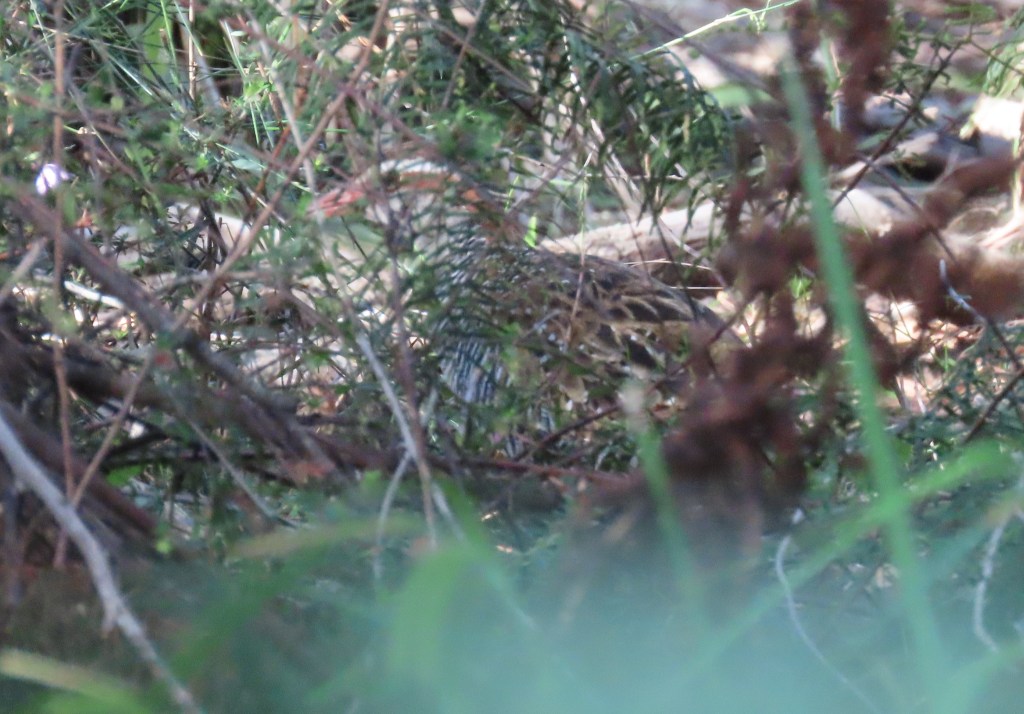
The bird has a distinctive wide white eyebrow, with a chestnut stripe through the eye. The top of the head is a darker brown, and the beak is orange and quite long. (At first I thought the bird was some sort of quail, but I couldn’t find any quails with orange beaks.) The body has black and white barring on the sides, whereas the plumage on the back is mottled brown and cream.
The bird hides in the low growth at the edge of Manly Dam, on Sydney’s northern beaches. I’ll keep a look out, to try and get a better photo.
Common name: Buff-banded Rail
Scientific name: Gallirallus philippensis
Length: 28-32 cm
Date spotted: 26 October 2024 (spring)
Location: Manly Dam Reserve, New South Wales, Australia: 33°46’40.0″S 151°14’50.2″E
What does a Darter sound like? Plus random turtles.
Darters are large water birds, a bit like cormorants. They make a weird cackling sound, a bit like a sardonic duck. And they only do it every now and then, for a short time, so you have to just be there with your camera ready if you want to record the call.
I was lucky to be looking at a kingfisher through the camera lens when a darter started cackling nearby. Here’s what I got on camera — the darter call is right at the start of the video. Also, when watching the video I noticed there are a couple of turtles on a log at bottom left of the shot, visible just as the camera starts zooming out.
Here’s the darter with its beak open. I’m not sure if it was thinking of cackling again or if something was tickling its throat. It is, after all, rather a long throat:
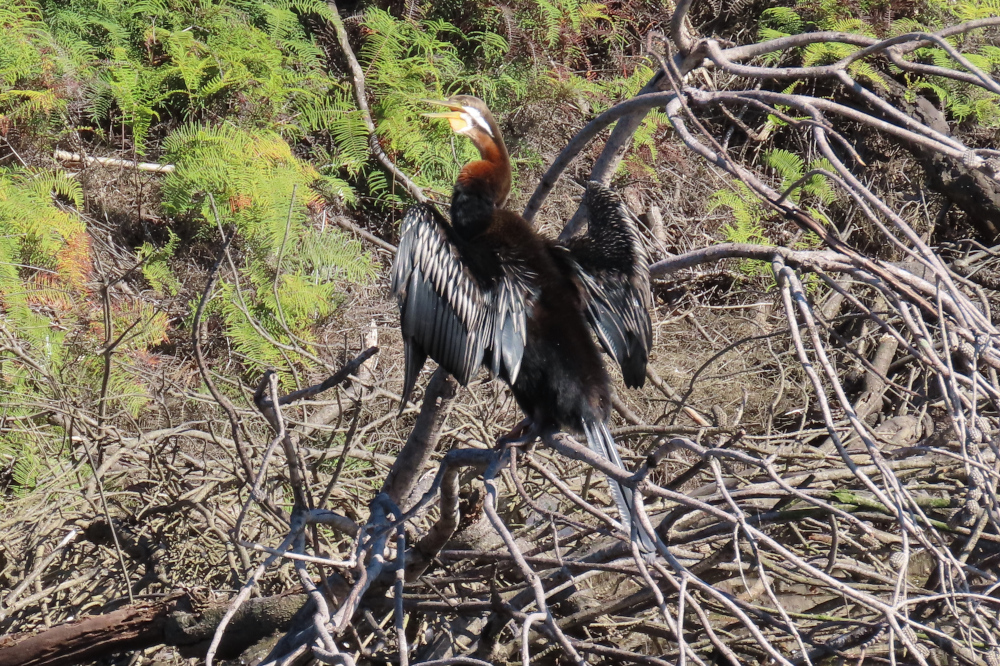
Here’s a pic showing the turtles on the log at bottom left. I didn’t know they were there until I saw the photos on a big screen. There are at least two turtles, one behind the other, and possibly a third below them:

This bird is a male, with its black neck and red throat.
Common name: Darter
Scientific name: Anhinga melanogaster
Approximate length: 90 cm; wing span: 1.2 m
Date spotted: 10 October 2024 (spring)
Location: Manly Dam Reserve, New South Wales, Australia: 33°46’34.7″S 151°14’48.9″E
My first Black-fronted Dotterels
Wandering the paths of Manly Dam reserve a couple of days ago, I met a fellow birdwatcher. He showed me some pictures of a bird that he’d seen, and asked me if I knew what it was. I didn’t, which of course was gratifying to both of us. Something new! I wandered along to the rocks where he’d seen the bird. Sure enough, two pretty little waterbirds dashed back and forth along the water’s edge, poking their beaks into the green sludge on the rocks. I managed to photograph one of them (though I’m not sure it’s always the same bird in these photos).

I wondered if it was some type of stilt, but the beak and legs weren’t long enough. My fellow birdwatcher had suggested it was a juvenile plover.

The bird had a distinctive V-shaped black marking on its chest.
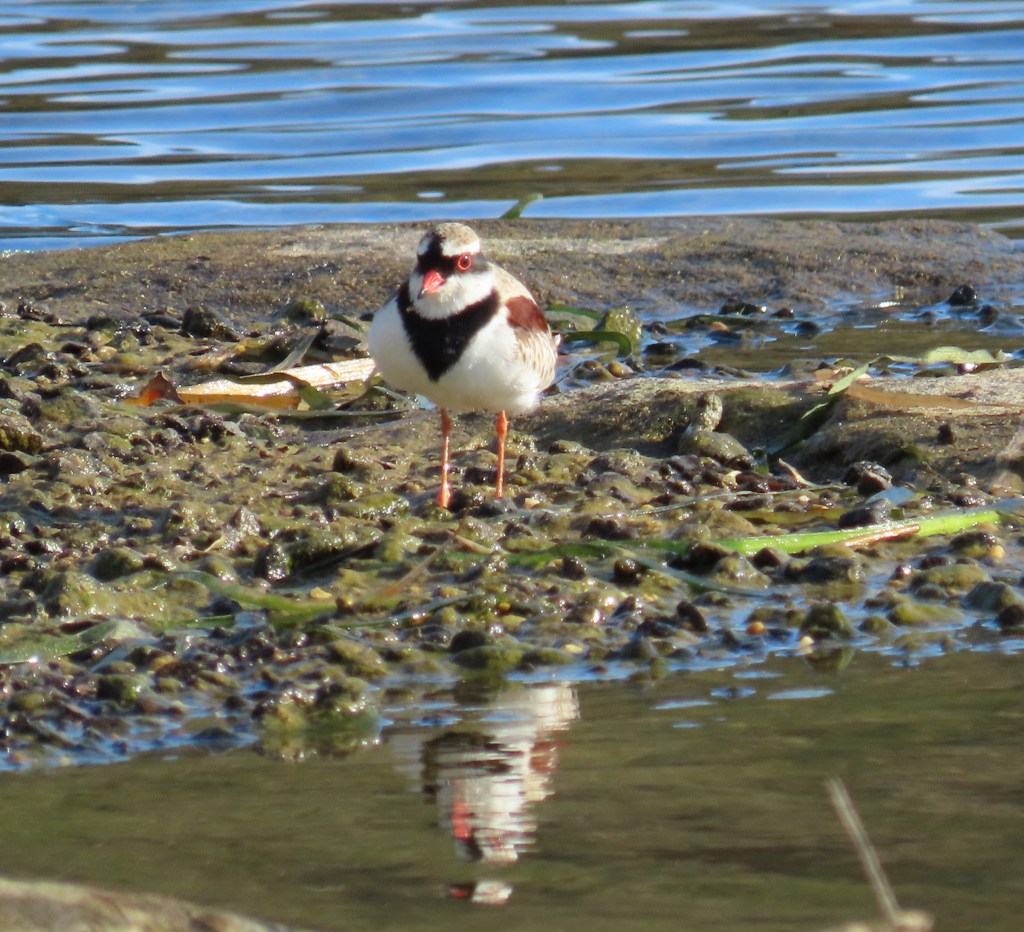
Consultation of my bird book revealed that these are Black-fronted Dotterels. They’re a type of plover. I heard them make their call, a series of short pips. Evidently they’re common and widespread, though I’ve not seen them in my area before.
Common name: Black-fronted Dotterel
Scientific name: Charadrius (Elseyornis) melanops
Approximate length: 16-18 cm
Date spotted: 22 September 2024 (spring)
Location: Manly Dam Park, New South Wales, Australia: 33°46’31.1″S 151°14’47.9″E
Masleep! Or, sleepy Pelican contortions
Early this morning, a pelican dozed on the banks of Manly Dam:

I’ve never seen a pelican asleep before. It looked a bit weird and back-to-front.

At one stage, the pelican decided a yawn was in order:
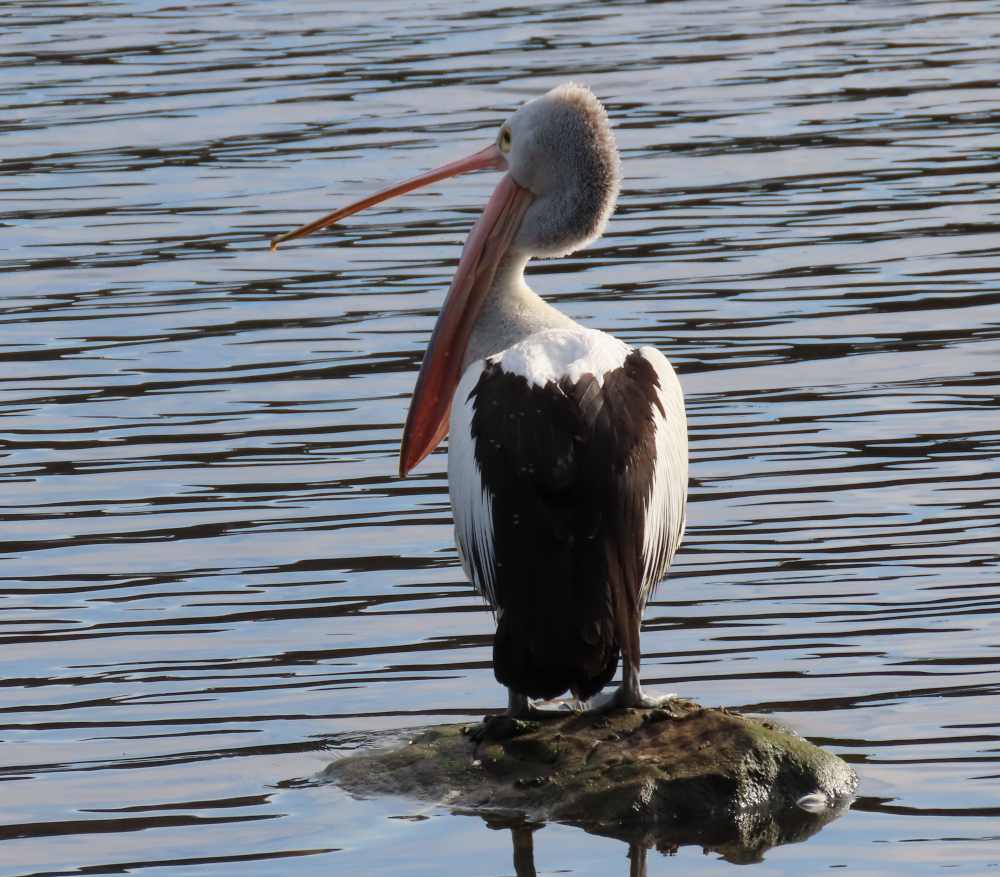
That pesky pouch beneath its beak got a bit tangled and inside-out:

Once that mess was sorted, the pelican manoeuvred its beak sideways onto its back:

With the beak nicely pointed straight down its back, the bird folded its wings over the beak. A bit like a bat, but the right way up!

Optimal sleeping position achieved:

Here’s the same bird, awake and looking as well put together as a pelican can:

It’s not often that you see a pelican at Manly Dam. I’m pretty sure this is a first for me, though I’ve seen them often on the beaches around Sydney.
Common name: Australian Pelican
Scientific name: Pelecanus conspicillatus
Approximate length: 170 cm
Approximate wingspan: 2.5m
Date spotted: 9 September 2024 (spring)
Location: Manly Dam Park, New South Wales, Australia: 33°46’31.2″S 151°14’46.6″E
Call of the Sacred Kingfisher
Ever wondered what a kingfisher sounds like? Well, you’ll know after watching this video, for a Sacred Kingfisher anyway. The call is a series of chirps, all on more or less the same note. Not very exciting really, for such a pretty bird! You hear them mostly around breeding time, when the calls can be quite insistent.
At the start of the video, you see and hear the kingfisher calling. The camera then zooms out to show the surroundings, including a Great Egret, a Darter, and a Coot. The scene is set at Manly Dam in Sydney’s Northern Beaches.
Set the video settings to HD for best results:
Despite their name, these kingfishers don’t often eat fish! Instead, they prey on small reptiles and large insects, and occasional crustaceans from the water’s edge.
Common name: Sacred Kingfisher
Scientific name: Todiramphus sanctus
Length: 20-23 cm
Date spotted: 8 September 2024 (spring)
Location: Manly Dam Park, New South Wales, Australia: 3°46’31.2″S 151°14’46.6″E
Looking great!
These two Great Cormorants were chilling at Manly Dam, in Sydney’s Northern Beaches. I didn’t realise how pretty their wing feathers are until I saw them through the camera zoom.
The first bird’s image is slightly spoiled by the bit of fluff on its nose, but check out those clear turquoise eyes and white-and-yellow face markings:
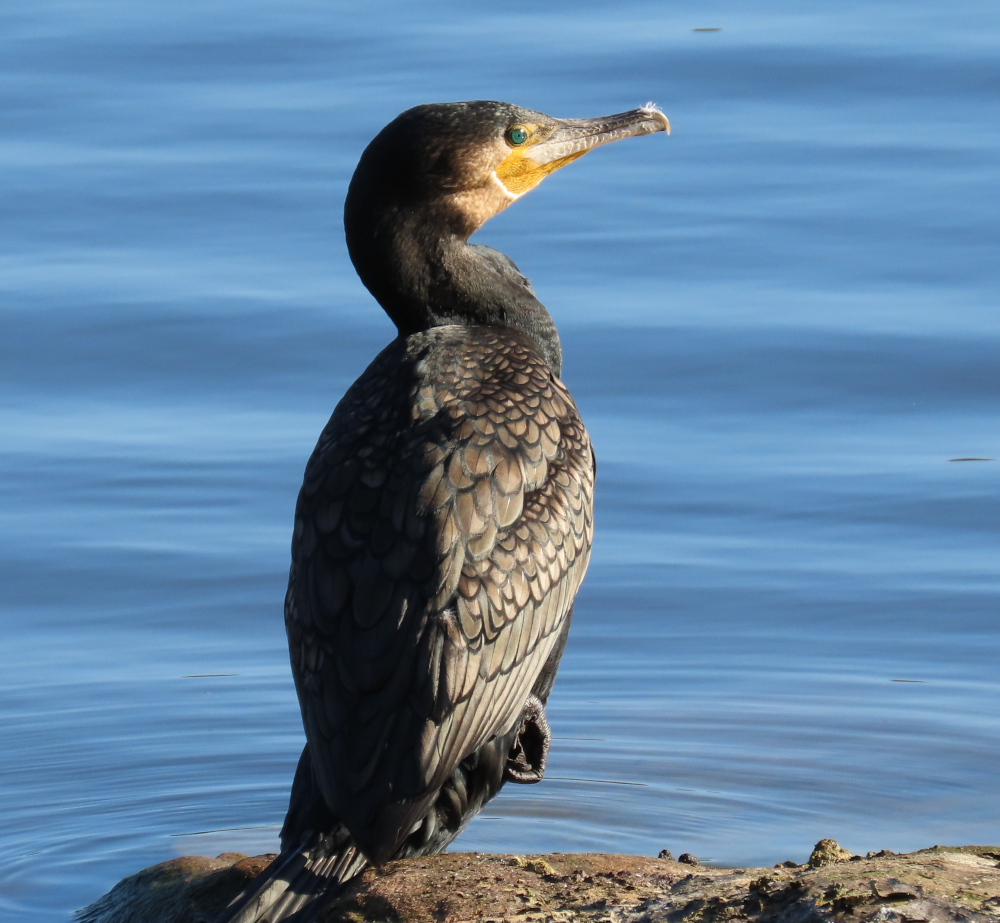
The second bird has no fluff problems, and stands proud:
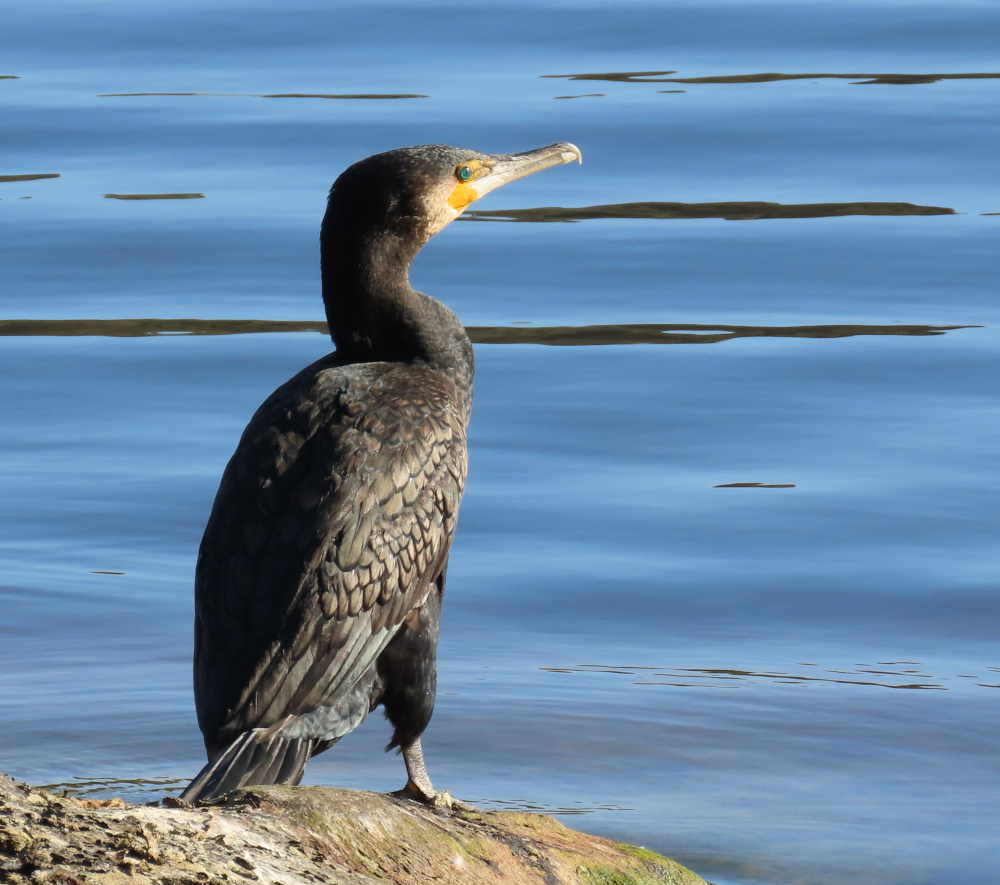
Common name: Great Cormorant
Scientific name: Phalacrocorax carbo
Approximate length: 85 cm; wing span 1.5 m
Date spotted: 6 September 2024 (spring)
Location: Manly Dam, New South Wales, Australia: 33°46’34.5″S 151°14’50.5″E
White-necked Herons in Sydney’s Northern Beaches
Yesterday, walking at the north western end of Manly Dam, I saw four large water birds flying high above the trees. Here are two of them:

Intrigued, I followed them around the corner where, luckily, they landed high in a tree. I managed to photograph two of them, before they took off again:
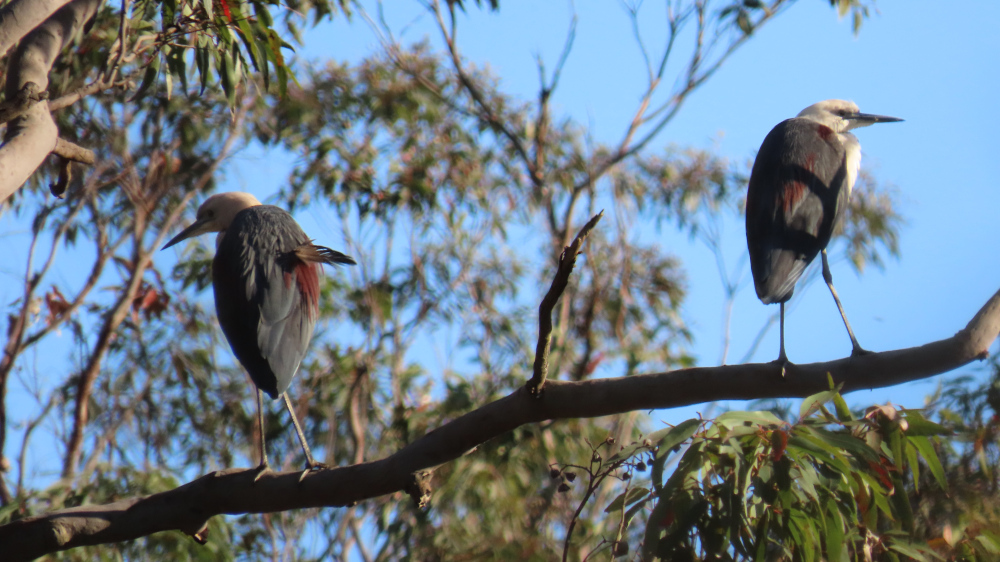
They’re White-necked Herons! This is my first sighting of these birds. They’re large and impressive, with those long legs and undertaker stance. The bird on the left has a misplaced feather that, combined with the reddish colouring on its wing tips, looks a little painful.
The birds were very high up, in the furthermost tree in this picture (though they had gone by the time I took the photo):
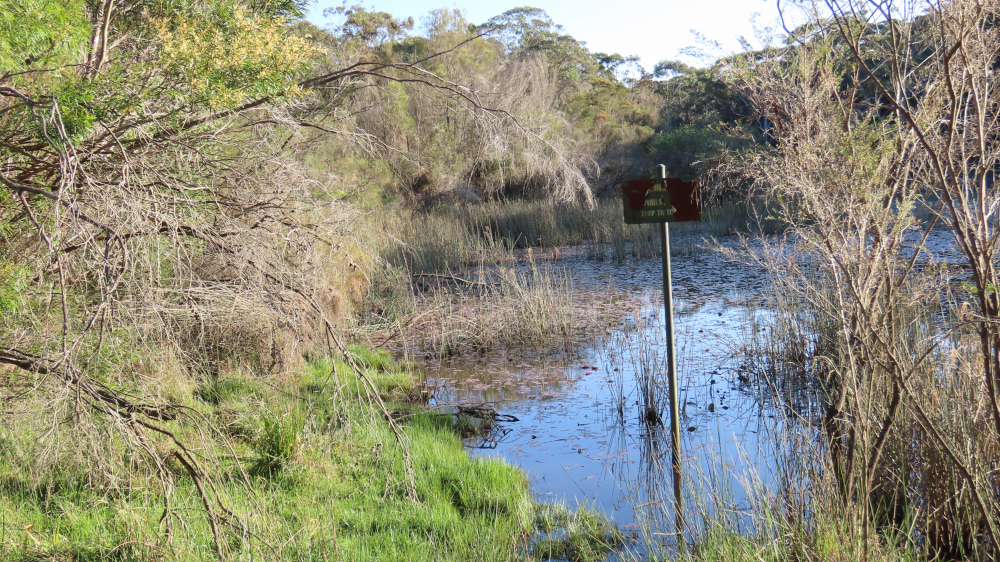
The left-most bird turned around at one stage, giving us a nice view of the spots running down its chest and the reddish marking at the top of its wings:
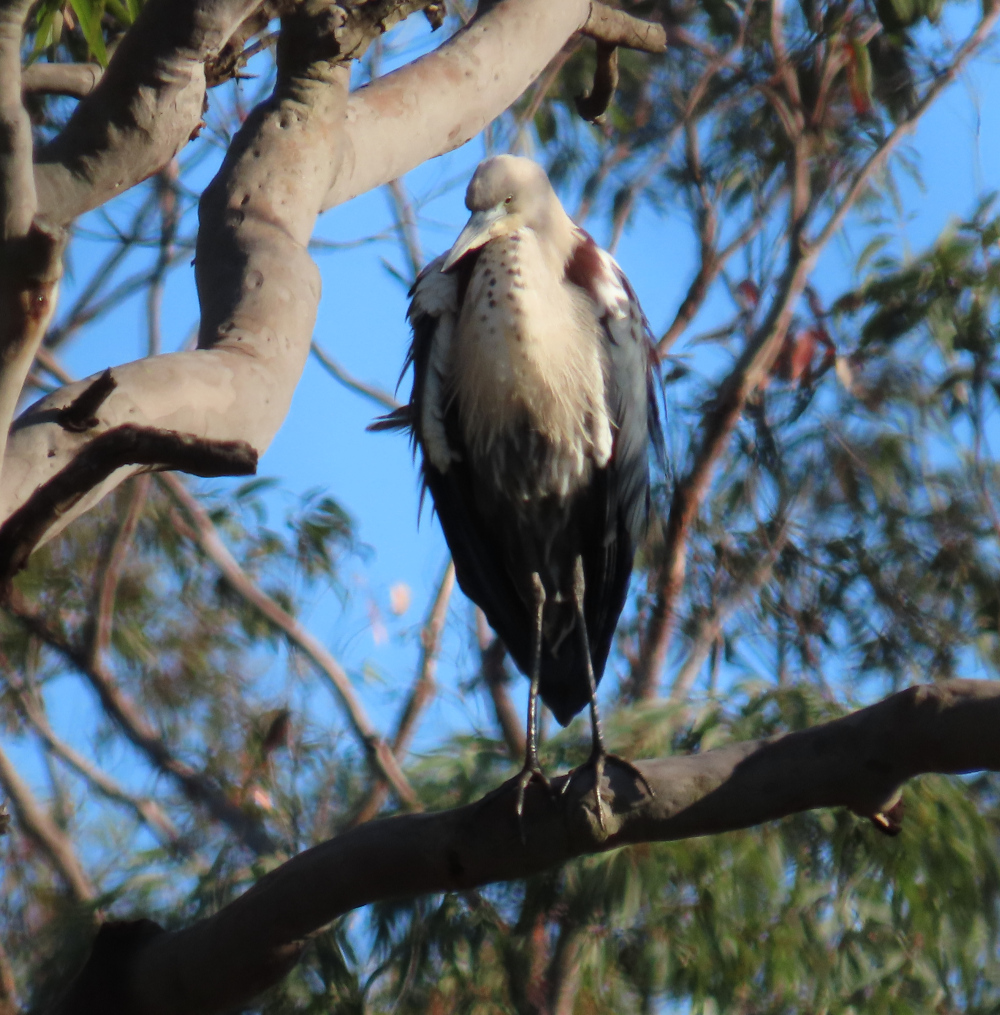
Another pose of the same bird:

This is the right-hand bird, looking altogether sleeker and fiercer:
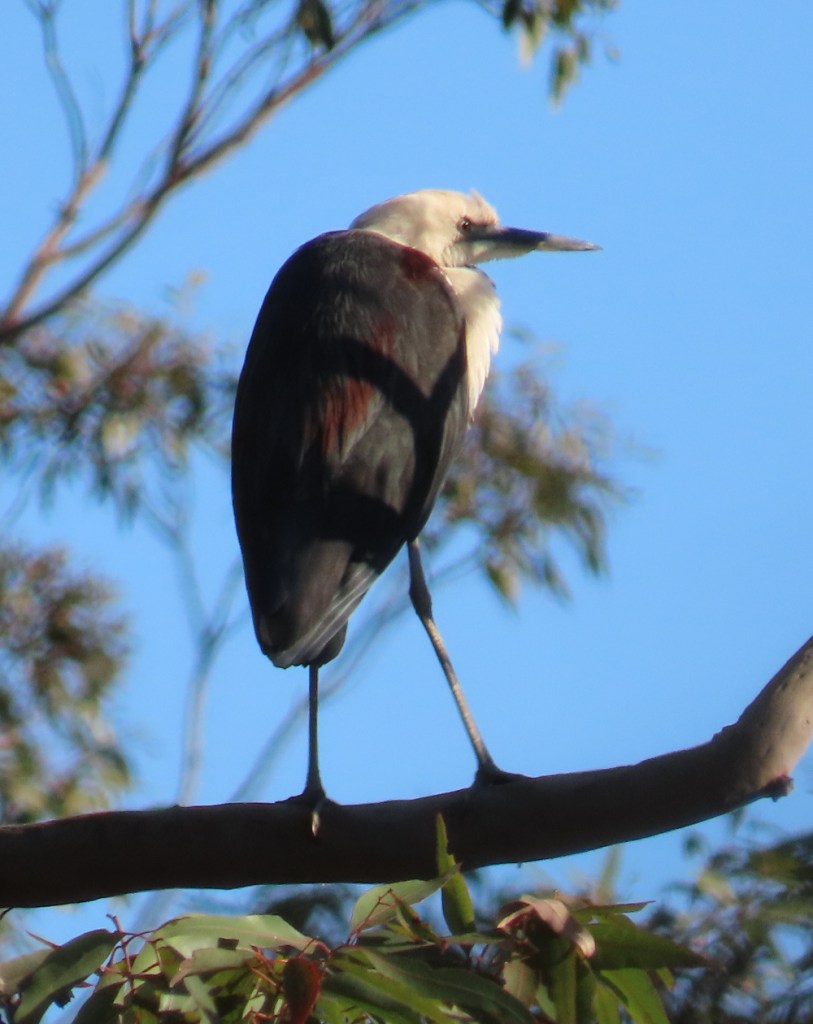
It’s exciting to see such large, impressive visitors at Manly Dam!
Common name: White-necked Heron
Scientific name: Ardea pacifica
Approximate length: 75-105 cm
Date spotted: 2 September 2024 (spring)
Location: Manly Creek in Manly Dam Reserve, New South Wales, Australia: 33°46’20.0″S 151°14’30.6″E
Great Egret at Manly Dam
This is the first time I’ve seen a Great Egret in this part of the world. My only other sightings were on a trip to Queensland a while ago.

They’re quiet and imposing birds. This one had a fluffy beak. I guess it had been doing some preening before I came along.

Common name: Great Egret
Scientific names: Ardea alba
Approximate length: 85 cm to 1.05 m
Date spotted: 26 July 2024 (winter)
Location: Manly Dam Park, near Sydney, Australia: 33°46’34.8″S 151°14’49.6″E
My first Tattler
A few weeks ago, I took some photos of a bird that I thought was a juvenile Oystercatcher. When I posted the pictures and location on eBird, a reviewer let me know that this is a Tattler, probably a Grey-tailed Tattler.
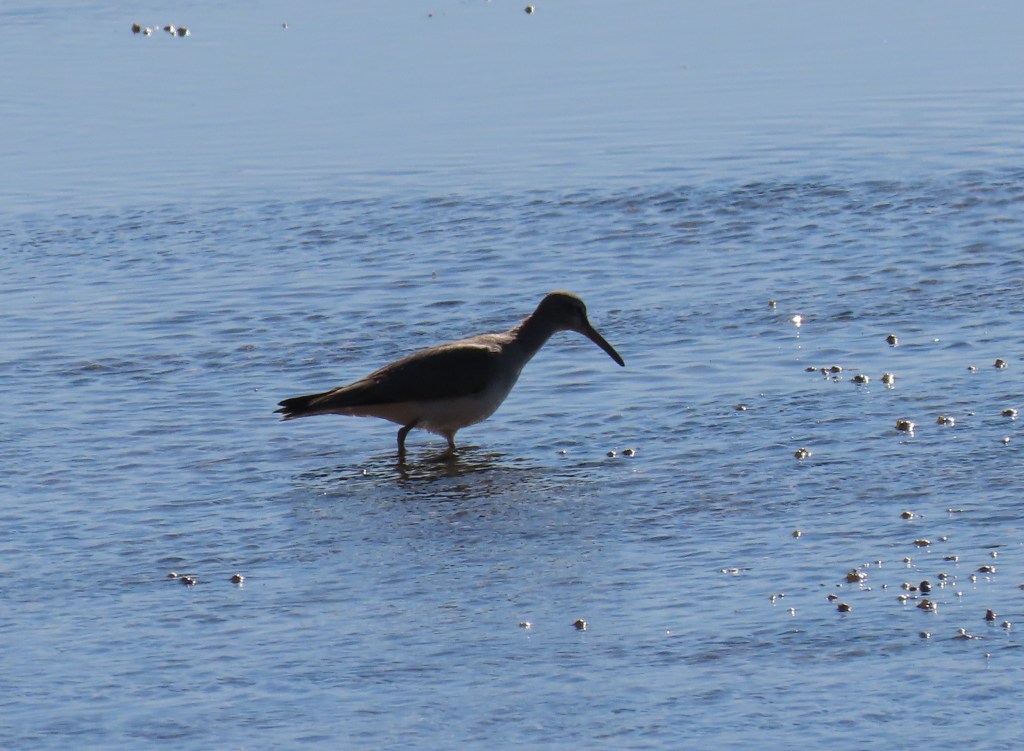
I was delighted to be corrected, and particularly so because this is the first time I’ve spotted a Tattler. These birds are uncommon in the south of Australia, particularly in winter.
The bird was wading in the shallows of the rocky plate that leads out into the ocean from Long Reef Headland. Every now and then, it probed the rocks below the water for food.
The lighting was harsh and the bird was far away, which made it difficult to get a good photo.

Common name: Tattler, probably a Grey-tailed Tattler
Scientific name: sp. Heteroscelus, probably Heteroscelus brevipes
Approximate length: 24-28 cm
Date spotted: 19 June 2024 (winter)
Location: Long Reef Aquatic Reserve, Collaroy, New South Wales, Australia: 33°44’19.7″S 151°18’42.0″E









